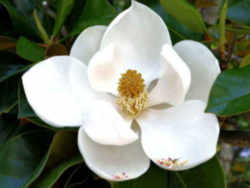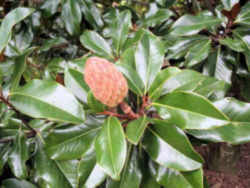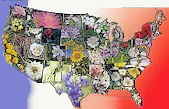
Mississippi Symbols
Mississippi State Flower
Magnolia

(Magnolia grandiflora)
Adopted on February 26, 1952.
Mississippi school children were allowed to vote for their state flower on November 28, 1900. The magnolia, cape jasmine, and yellow jasmine were favorites. In all, children voted for forty-two flowers. Out of 23,278 votes, the magnolia received 12,745. It was not made official by the legislature. In 1935, Mississippi's Director of Forestry started a state tree movement, again allowing school children to vote. The magnolia again won by a landslide. It was adopted on April 1, 1938.
On February 26, 1952, the magnolia, (Magnolia grandiflora,) was finally officially adopted as Mississippi's state flower. Native to Asia, the magnolia was named for the great French botanist Pierre Magnol, who died in 1715.
Mississippi State Flower: Magnolia

Southern magnolia, also called evergreen magnolia, bull-bay, big-laurel, or large-flower magnolia, has large fragrant white flowers and evergreen leaves that make it one of the most splendid of forest trees and a very popular ornamental that has been planted around the world. This moderately fast-growing medium-sized tree grows best on rich, moist, well-drained soils of the bottoms and low uplands of the Coastal Plains of Southeastern United States. It grows with other hardwoods and is marketed as magnolia lumber along with other magnolia species to make furniture, pallets, and veneer. Wildlife eat the seeds, and florists prize the leathery foliage.
Characteristics of the Magnolia
- Size: - 60 to 80 feet in height with a spread of about 30 to 50 feet. It develops into a large tree in southeastern Virginia, but in western
Virginia its height may not exceed 20 feet due to occasional winter damage.
There are numerous cultivars, and there can be variation between seedlings. Grows at about a medium rate with a pyramidal habit. Generally branched to the ground and best left this way since growing anything under them is futile. - Leaf: Alternate, simple, pinnately veined and evergreen, 5 to 8 inches long, oval in shape with an entire margin. Very waxy/shiny above, and reddish tomentose below.
- Flower: Southern magnolia has large, showy white flowers 6 to 8 inches wide with large white petals. Flower size ranges from extremely large blooms over 15 inches wide (Magnolia delavyii and Mag. grandiflora), to very small flowers less than 1 inch wide (Michellia figo). These have a pleasant fragrance and appear throughout the spring and summer. Fragrance can range from overpowering musty smells to sweet tropical fruit smells. Most evergreen members of the Magnoliaceae do have a distinct smell. The flowers open slowly as the large blossom needs time to develop. The center of the blossom is intricate and attractive as well. Flower color is basically an off white or cream color. Flowers are pure white, fragrant, but last only one day after opening. As flowers age they often develop a yellow cast to them. Yellow (often with green or purple undertones) flower color can be found in Michellia figo. Rare pink flowers can be found in Magnolia virginiana and Michellia affinis. A red flowered form of Magnolia delayvii has been reported. Flowers are borne singly in spring to early summer from May to June, but in general the trees do not begin blooming until their seventh year, once their growth rate has decreased (Odenwald and Turner, 1996).
- Fruit: The fruits are reddish-brown cone like structures, 2-4 in (5-10 cm) long, with bright red kidney shaped seeds that hang from little threads when fully mature in autumn. Maturing October to November.
- Twig: Stout, with white to rusty tomentum and a long (1 to 1 1/2 inches) silky white to rusty red terminal bud.
- Bark: Brown to gray, thin, smooth/lenticellate when young, later with close plates or scales.
- Form: A medium-sized tree with a pyramidal crown. When open grown, the crown is dense with low branches.
The Mississippi Code
The law designating the magnolia or evergreen magnolia as the official Mississippi state flower is found in the Mississippi Code, Title 3, Chapter 3, Section 3-3-13.
TITLE 3. STATE SOVEREIGNTY, JURISTICTION AND HOLIDAYS.
CHAPTER 3. STATE BOUNDARIES, HOLIDAYS, AND STATE EMBLEMS.
SECTION 3-3-13.
§ 3-3-13. State flower.
The flower or bloom of the magnolia or evergreen magnolia (Magnolia grandiflora L.) is hereby designated as the state flower of Mississippi.
Sources: Codes, 1942, § 6192-02; Laws, 1952, ch. 340.
Taxonomic Hierarchy: Magnolia
Kingdom: Plantae - Plants
Subkingdom: Tracheobionta - Vascular plants
Superdivision: Spermatophyta - Seed plants
Division: Magnoliophyta - Flowering plants
Class: Magnoliopsida - Dicotyledons
Subclass: Magnoliidae
Order: Magnoliales
Family: Magnoliaceae - Magnolia family
Genus: Magnolia L. - magnolia
Species: Magnolia grandiflora L. - southern magnolia
State Floral Emblems







